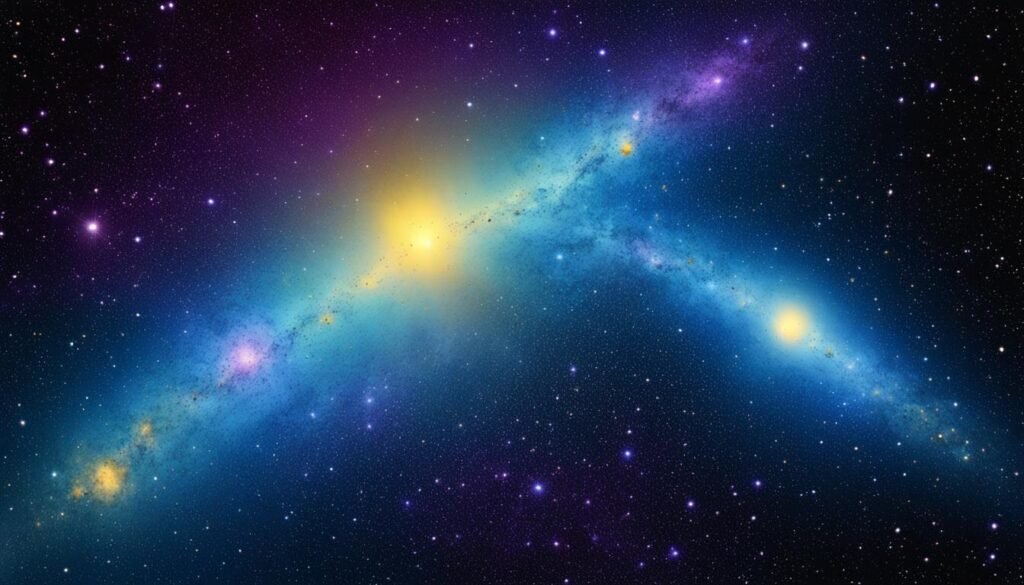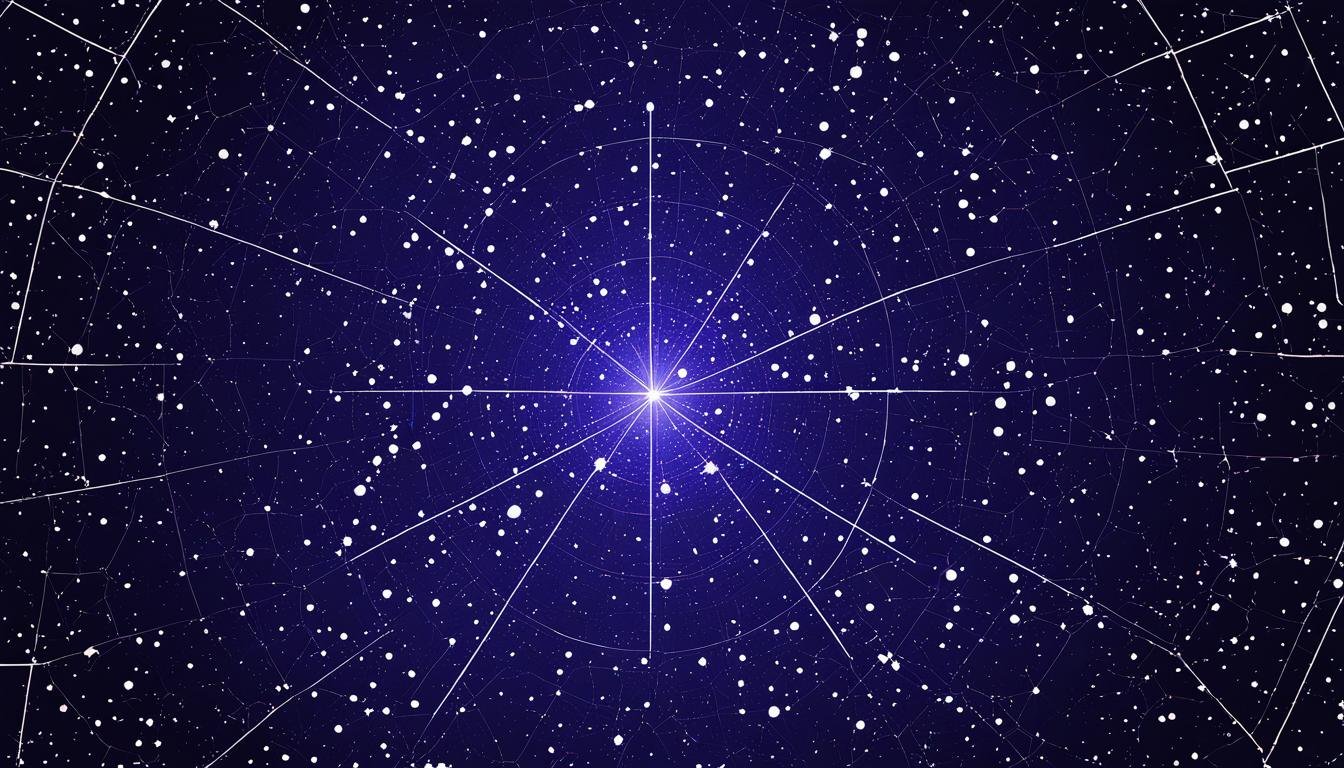| Genitive | |
| Abbreviation | |
| Pronunciation | |
| Main Stars | |
| Brightest Star | |
| Right Ascension | |
| Declination | |
| Sq. Deg. Area | |
| Crosses Meridian | |
| Visible Lat. Range |
As you gaze into the starry expanse, the Constellation Reticulum emerges as a celestial tapestry woven with history and mythology in the Southern Hemisphere’s skies. While it may not boast the fame of its more flamboyant neighbors, this quaint pattern of stars holds a charm for those passionate about the cosmos. With origins dating back to the 17th century, this Southern Hemisphere constellation serves as a window into ancient cultures that looked to the heavens for guidance and understanding. Known for its intricate star patterns and serving as a reference in the Reticulum astrological sign, this constellation encapsulates the wonder of nocturnal observations.
The radiant Reticulum celestial bodies tell tales not just of stellar formations, but of human discovery and innovation. From the eyepiece of a telescope—a reticle—which inspired its naming, to the astral navigation tools that have steered mariners through uncharted waters, Reticulum stands as a tribute to both stellar and terrestrial ingenuity. But don’t let its diminutive size belie its importance; within Reticulum’s confines lie cosmic tales waiting to be discovered.
Key Takeaways
- Uncover the history and significance of the Constellation Reticulum, first documented by German astronomer Isaac Habrecht II.
- Explore the variety of stars making up the Southern Hemisphere constellation, including bright giants and elaborate multi-star systems.
- Appreciate the Reticulum astrological sign and its role in historical navigation and astrological practices.
- Dive into the narratives of Reticulum celestial bodies, linking them to human stories of exploration, both at sea and in the heavens above.
- Gain understanding of the constellation’s place within the broader tapestry of celestial formations and its relatively recent addition to recognized star patterns.
Unveiling the Mysteries of Constellation Reticulum
Embark on an astronomical journey to uncover the secrets of Constellation Reticulum, a celestial network steeped in history and glittering with stars and galaxies. From its initial discovery to the deep sky wonders it harbors, Reticulum serves as a stunning embodiment of cosmic discovery and enlightenment.
The Historical Lens: Discovery and Nomenclature
The story of Constellation Reticulum begins with Isaac Habrecht II, who first charted this celestial pattern as Rhombus in 1621. Years later, Nicolas Louis de Lacaille left his mark on the heavens, honoring his reticle tool by renaming it to Reticulum during his astronomical pursuits south of the equator. It was a tribute to the intricate navigation aids of the skies. Officially recognized by the International Astronomical Union in 1922, Reticulum’s name reflects the precision required for celestial mapping and navigation.
Guiding Stars: Analyzing Reticulum’s Notable Celestial Bodies
In the Reticulum zodiac, stars such as Alpha Reticuli, Beta Reticuli, and Epsilon Reticuli serve as stellar beacons, lighting up the intricate Reticulum star patterns. Alpha Reticuli, the constellation’s brightest star, casts a luminous glow with an apparent magnitude of 3.33, while Beta Reticuli’s triple system and Epsilon Reticuli’s binary nature showcase the celestial diversity within this constellation.
- Alpha Reticuli: The brightest star with insights into the stellar evolution and X-ray emissions
- Beta Reticuli: A compelling triple system situated a mere 100 light-years away
- Epsilon Reticuli: A system featuring an orange subgiant paired with a white dwarf
Deep Sky Wonders: Exploring Reticulum’s Galactic Marvels
Looking beyond the twinkling stars, Reticulum is home to a collection of Reticulum deep sky objects that captivate astronomers across the globe. The barred spiral galaxy known as NGC 1559, classified as a Seyfert galaxy, is a bastion of vibrant star formations and phenomenal supernova events. Meanwhile, the asymmetrical beauty of the Topsy Turvy Galaxy – NGC 1313 demands attention with its unique axis of rotation and status as a starburst galaxy. These cosmic phenomena, millions of light-years away, amplify Reticulum’s role in the celestial narrative.
| Object | Type | Description | Distance (Million Light Years) |
|---|---|---|---|
| NGC 1559 | Barred Spiral Galaxy | Host to supernovae and strong radio emissions | Approx. 50 |
| Topsy Turvy Galaxy – NGC 1313 | Starburst Galaxy | Noted for off-center rotation and intense star-forming activity | Approx. 14 |
Constellation Reticulum’s Place in the Night Sky
When you gaze upon the night sky from the Southern Hemisphere, the constellation Reticulum presents itself as an exquisite celestial mosaic. This Southern Hemisphere constellation, comfortably nestled within the SQ1 quadrant, offers a compelling sight for both the casual onlooker and the avid astronomer. Its intricate Reticulum star patterns are best appreciated during certain times of the year, at specific latitudes where the constellational backdrop emerges in its full glory.
Amidst the Southern Hemisphere’s stellar canvas, the Reticulum astronomical observations are enriched by the presence of its neighboring constellations—Dorado, Horologium, and Hydrus. Each of these celestial neighbors contributes to the viewing experience, enhancing the navigational and observational quality of the astronomical journey. Reticulum’s role in assisting navigation across the seas or the study of the cosmos cannot be overstated, as its star patterns serve as a guide for exploring the depths of the universe.

The allure of the Reticulum constellation can be broken down into its stellar components, which together weave an awe-inspiring narrative in the heavens. Below is a comprehensive table to acquaint you with Reticulum’s stellar framework and guide your observations:
| Star Name | Apparent Magnitude | Stellar Classification | Notable Features |
|---|---|---|---|
| Alpha Reticuli | 3.33 | Giant | Brightest in the constellation, Observable without a telescope |
| Beta Reticuli | 3.85 | Triple star system | Consists of a binary pair and a distant companion |
| Epsilon Reticuli | 4.44 | Binary star | Orange subgiant and white dwarf components |
| Zeta Reticuli | 5.22 & 5.24 | Binary solar-like system | Gravitationally linked, resembling our Sun |
Discovering Reticulum requires patient astronomical observations, but the rewards are bountiful. The detailed star patterns of this constellation serve as a cosmic map to the unexplored terrains of the night sky. As you embark on this journey, take a moment to appreciate the celestial artistry that adorns the domain of the Reticulum constellation—a true astronomical marvel in the Southern Hemisphere.
Alpha Reticuli and Its Stellar Neighbors
As you gaze into the night sky, you’re looking not only at the individual stars but also at the grand tapestry they weave together. The Reticulum star constellation, a symphony of stellar beauty, holds the Reticulum astrological sign which shares the heavens with celestial luminaries such as Alpha Reticuliand Beta Reticuli.
Spotlight on Alpha Reticuli: Reticulum’s Brightest Star
At the heart of this celestial network lies Alpha Reticuli, a star that effortlessly claims the title of the Reticulum constellation’s most radiant point. Sitting about 161.6 light-years away from Earth, it shines with an apparent magnitude of 3.315. As a G8 II-III class star, Alpha Reticuli has ascended beyond its main-sequence phase, clear evidence of the dynamic evolution of stars within the Reticulum star constellation.

Astrological Companions: Stars that Accompany Alpha Reticuli
Yet, Alpha Reticuli does not stand alone. Its luminosity is complemented by the likes of Beta Reticuli and Epsilon Reticuli, both significant astrological beacons within their own right. Each of these stellar bodies contributes to the Reticulum astrological sign, a testament to the celestial diversity present within this constellation.
The Binary and Multiple Star Systems of Reticulum
The Reticulum constellation is far from a single-star affair; it’s a haven for binary and multiple star systems that exemplify the wonders of the cosmos. Notable among these is Zeta Reticuli, a solar-analog binary system, that echoes the very essence of our own sun. Another captivating system is Kappa Reticuli, with its dominant F5IV-V subgiant showcasing the rich complexity of Reticulum star patterns.
| Star/System | Class | Apparent Magnitude | Notable Features |
|---|---|---|---|
| Alpha Reticuli | G8 II-III | 3.315 | Brightest star in Reticulum, advanced stage of stellar evolution |
| Beta Reticuli | K1 III | 3.85 | Orange giant, triple star system |
| Epsilon Reticuli | K4 III | 4.44 | Binary star with orange subgiant and white dwarf companion |
| Zeta Reticuli | G2 V | 5.24, 5.20 | Binary star system with sun-like stars |
| Kappa Reticuli | F5 IV-V | 4.72 | Binary system with a subgiant primary |
When you contemplate the stars tonight, remember the multitude of stellar phenomena, from binary star systems to the storied Reticulum star patterns, each play their part in the grand celestial drama.
Discovering Reticulum’s Deep Sky Objects
If your stargazing adventures guide you toward the southern sky, the Reticulum constellation awaits with astonishments that reach far beyond our solar system. Within this celestial expanse, you will uncover Reticulum deep sky objects that are both fascinating and complex. Peer through your telescope, and you may observe the likes of NGC 1559, a barred spiral galaxy that serves as a celestial canvas for an array of star formation events and supernovae. This particular galaxy is a well-known Seyfert galaxy, brimming with active galactic nuclei that hint at the dynamic processes at play in the universe.
The intrigue does not end with NGC 1559—it is just the beginning. Venture deeper into the Reticulum constellation and you will encounter the Topsy Turvy Galaxy, also known as NGC 1313. Its very name suggests its uncommon configuration—an irregular, asymmetric form that makes it a standout starburst galaxy. Unlike others of its kind, NGC 1313 lies in solitude, without the company of neighboring galaxies, compelling you to ponder the forces that have shaped its unique presence in the cosmos.
Reticulum paves a pathway for amateur and professional astronomers to delve into the stories woven into the fabric of the night sky. Each of its deep sky objects acts as a narrative piece—a cosmic clue as to how galaxies are born, live, and often spectacularly cease to be, through events as grand as supernovae. With eyes set upon these distant marvels, you are participating in an age-old human endeavor to map and understand the vast, enigmatic universe that surrounds us.
FAQ
What is the Reticulum constellation and where is it located?
The Reticulum constellation is a small group of stars located in the Southern Hemisphere’s celestial sphere. Known for its distinctive reticle-like pattern, it is officially recognized and designated by the International Astronomical Union with the abbreviation ‘Ret’.
Who discovered the Reticulum constellation and what did they name it?
The Reticulum constellation was originally discovered by German astronomer Isaac Habrecht II in 1621 and named “Rhombus.” Later, French astronomer Nicolas Louis de Lacaille renamed it to “Reticulum” after the reticle of a telescope during the mid-18th century.
What are the key celestial bodies in the Reticulum constellation?
Key celestial bodies in the Reticulum constellation include Alpha Reticuli, the brightest star in the constellation, and other notable stars such as Beta Reticuli, a triple star system, and Epsilon Reticuli, which is known for its binary components. The constellation also features several deep sky objects like NGC 1559, a barred spiral Seyfert galaxy, and NGC 1313, also known as the Topsy Turvy Galaxy.
What is the significance of Alpha Reticuli?
Alpha Reticuli is the most luminous star in the Reticulum constellation with an apparent magnitude of 3.33. Classified as a bright giant, it is significant for its advanced evolutionary stage and serves as a guide for astronomical observations within the constellation.
Can you see the Reticulum constellation throughout the year?
Visibility of the Reticulum constellation depends on your location. It can be seen best from the Southern Hemisphere, generally between latitudes +23° and -90° and is most visible during specific months when it is above the horizon at night.
Are there any zodiac signs associated with the Reticulum constellation?
The Reticulum constellation is not one of the traditional zodiac constellations that lie along the ecliptic plane. As such, it is not associated with any astrological signs in the zodiac system.
What are some deep sky objects found in Reticulum?
The Reticulum constellation contains several deep sky objects, including NGC 1559, a barred spiral galaxy with active star formation and supernovae, as well as the Topsy Turvy Galaxy (NGC 1313), known for its irregular shape and starburst qualities.
How does one identify the star patterns of Reticulum?
To identify the star patterns of Reticulum, one must locate its brightest star, Alpha Reticuli, and use it as an anchor to trace the constellation’s distinct net-like pattern. It is also helpful to identify surrounding constellations such as Dorado and Horologium for context.







